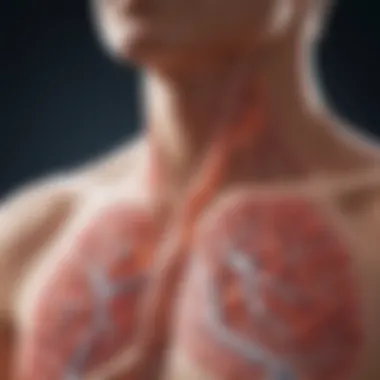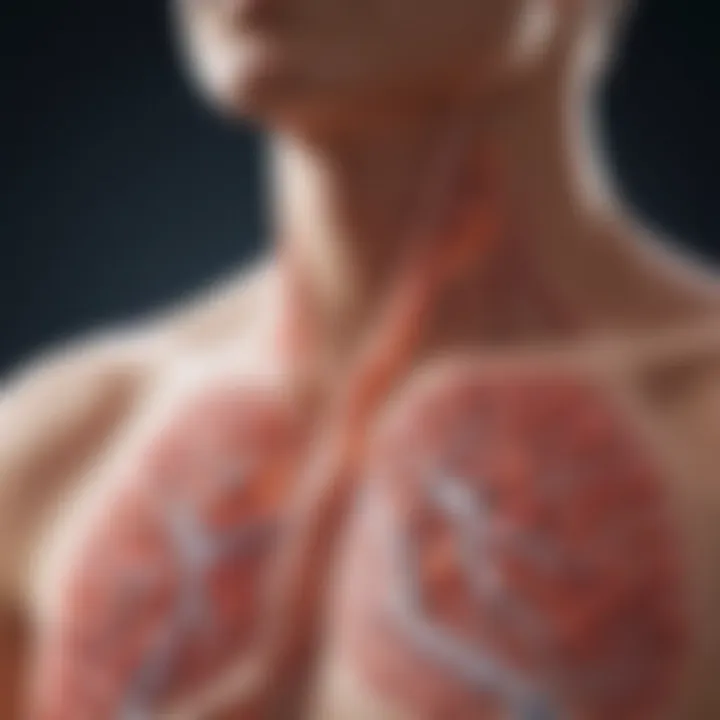Recognizing Symptoms of Worsening COPD


Intro
Chronic Obstructive Pulmonary Disease (COPD) stands as a major health concern around the globe, affecting millions of individuals. It's a complex condition characterized by persistent respiratory symptoms and an obstruction in airflow. When COPD exacerbates, whether due to infection, pollution, or other triggers, it results in a marked increase in symptoms. Understanding the signs and implications of an exacerbation not only aids in timely intervention but also enhances the quality of life for those affected.
In this article, we seek to shed light on the nuances of exacerbated COPD. We’ll explore the various symptoms that manifest, the psychological toll, and the alarming signs that may signal the need for immediate medical attention. Additionally, we’ll delve into self-management strategies that can empower patients to take charge of their health.
The information presented here is pivotal for students, researchers, educators, and professionals looking to deepen their understanding of COPD and its exacerbations. With a thorough examination of the existing literature, clinical findings, and patient experiences, we hope to arm readers with knowledge that is both practical and profound.
Research Overview
Summary of Key Findings
Research indicates that symptoms of exacerbated COPD can fluctuate wildly between individuals, yet several key symptoms are commonly observed. These include increased breathlessness, coughing, and sputum production. Importantly, these manifestations can severely impact daily living, leading to increased hospital visits and overall distress.
A significant finding from recent studies indicates that psychological symptoms, such as anxiety and depression, often coincide with physical symptoms during exacerbations. Patients may feel trapped in a cycle where physical restrictions promote psychological distress and vice versa.
Relevance to Current Scientific Discussions
The conversation surrounding COPD has shifted in recent years, with a stronger emphasis on the holistic approach to treatment. Research now underscores the importance of considering both the physical and mental health of COPD patients, urging the medical community to adopt strategies that encompass overall well-being. This paradigm shift highlights how symptoms do not exist in isolation and how interconnected ailments can hamper effective treatment.
Methodology
Research Design and Approach
The studies referenced in our examination utilized a cross-sectional design to investigate symptoms experienced by COPD patients during exacerbations. This approach allowed for a broad assessment of various symptoms and their relationship with both physical health and psychological well-being.
Data Collection and Analysis Techniques
Data was collected from a diverse range of participants using surveys and in-depth interviews. These methods not only captured quantitative data but also offered rich qualitative insights into the lived experiences of individuals suffering from exacerbated COPD.
Throughout this exploration, an emphasis will be placed on practical insights to empower readers in recognizing symptoms early and implementing effective self-management strategies.
Preamble to COPD
Chronic Obstructive Pulmonary Disease, commonly referred to as COPD, is not just a medical diagnosis; it signifies a multifaceted struggle affecting millions worldwide. A deeper look into this condition reveals how it doesn't merely impede breathing but also intertwines with individuals' daily lives, emotions, and prospects. This section aims to lay the groundwork for understanding not just what COPD is, but why recognizing its nuances is vital for patients, caregivers, and healthcare professionals alike. The more we understand, the better positioned we are to combat this relentless foe.
Definition and Overview
COPD encompasses a group of lung diseases that cause airflow blockage and breathing-related difficulties. Two of the predominant conditions under this umbrella are emphysema and chronic bronchitis. In simple terms, emphysema damages the air sacs in the lungs, leading to difficulty in gas exchange, while chronic bronchitis involves inflammation and narrowing of the bronchial tubes, which leads to persistent cough and mucus production. The term ‘chronic’ underscores its progressive nature, often gradually worsening over time, making early intervention crucial.
The symptoms can vary widely among individuals, often making diagnosis a complex endeavor. A common thread tying together the experiences of those living with COPD is the relentless feeling of breathlessness, which can significantly affect one's ability to engage in everyday activities. The continual struggle can dampen overall quality of life, necessitating a comprehensive understanding of the disease.
Epidemiology and Prevalence
COPD is a global health concern, affecting approximately 251 million people as reported by the World Health Organization. This staggering number paints a stark picture of its prevalence, yet the statistics are more than just numbers; they reflect the countless lives intertwined with COPD. Moreover, this disease ranks as the third leading cause of death worldwide, a grim reminder of the urgency of addressing it.
The epidemiology of COPD reveals significant trends based on various factors, including age, gender, and lifestyle choices. Interestingly, while it was once deemed predominantly a disease of older individuals, more recent studies suggest shifts towards younger populations, often exacerbated by lifestyle factors such as smoking, pollution, and occupational hazards. In many urban settings, the combination of toxic air quality and an aging demographic poses a particular challenge for healthcare systems.
Understanding the prevalence of COPD can guide public health efforts and resource allocation. Increased awareness regarding risk factors can lead to preventative measures, potentially reducing new cases. Furthermore, early diagnosis remains a critical step in managing the condition effectively, shining a light on the importance of education and resources available for both healthcare providers and patients.
Understanding Exacerbations
Understanding exacerbations is crucial not just for those living with Chronic Obstructive Pulmonary Disease (COPD), but also for caregivers and healthcare professionals. An exacerbation, which refers to a period where symptoms dramatically worsen, can peck away at a patient’s quality of life. Each episode often heralds new challenges and complications, making it wises to grasp the why and how.


The importance of recognizing exacerbations lies in their potential risks. When untreated, they can lead to severe consequences including hospitalization, progressive lung decline, and increased mortality. Thus, early identification is key to effective management and could be the thin line between merely existing or truly living.
Additionally, understanding exacerbations fosters proactive strategies. Knowledge of triggers can help patients make informed choices, warding off situations that might send them spiraling back into distress. Managing one’s environment, adhering to treatment, and being vigilant about one’s wellbeing can all hinge on an acute awareness of these crucial episodes.
What Constitutes an Exacerbation?
An exacerbation often manifests as a noticeable increase in the severity of symptoms, which might include coughing, breathlessness, or expectoration of more mucus than usual. This uptick can result from various internal and external factors impacting lung function. Essentially, while all patients experience fluctuations, an exacerbation is marked by its clinical presentation—symptoms worsening beyond what is typical for an individual.
In general, an exacerbation may be considered a failure of the basic self-management routines in place. Patients may feel overwhelmed, and it is not uncommon for them to confuse an ordinary flare-up with a full-blown exacerbation. Thus, laying down the baseline for each patient is vital: knowing what’s normal for them can help differentiate an exacerbation from everyday symptoms.
Common Triggers of Exacerbations
Environmental Factors
Environmental factors are significant contributors to COPD exacerbations. Changes in weather, variations in temperature, or high humidity can be particularly troublesome. The key characteristic of these factors is their ubiquity; they are often unavoidable and can strike without warning. Sudden cold snaps or heatwaves might further compromise lung function, a unique feature that demands careful monitoring.
- Advantages: When patients remain aware of environmental changes, they can better prepare. For example, wearing a mask on high-pollen days or staying indoors during cold winds can mitigate risks.
- Disadvantages: However, not every patient can control their environment, especially those living in urban areas with significant air pollution.
Respiratory Infections
Respiratory infections, both viral and bacterial, often trigger exacerbations in COPD patients. The connection is straightforward: infections worsen inflammation in the airways, leading to more severe symptoms. What makes this trigger particularly concerning is the rapid onset of changes, often turning a regular day into a struggle for breath.
- Key Characteristic: The contagious nature of infections, especially during flu season, poses risks to all as it can quickly spread within communities.
- Unique Feature: As infections can sometimes be mild, COPD patients may find it hard to gauge how much they are worsening. This factor can contribute to underestimating the severity of an exacerbation until symptoms peak dramatically.
Pollutant Exposure
Pollutant exposure is another key factor that can't be overlooked. This includes everything from smoke, industrial chemicals, fumes from vehicles, and even indoor pollutants like volatile organic compounds. The notable characteristic of pollutants is that they are often linked to lifestyle and location choices. Some individuals are regularly exposed due to their living conditions, making this a prevalent trigger.
- Advantages: Awareness about pollutants has surged, allowing COPD patients to engage in discussions about air quality, potentially leading to policy changes in some communities.
- Disadvantages: Awareness alone does not shield individuals; many still face high exposure levels regardless of their understanding of the risks involved.
Recognizing the signs of exacerbation and understanding triggers can play a pivotal role in managing COPD effectively. A proactive approach not only minimizes risks but significantly enriches the quality of life.
Key Symptoms of Exacerbated COPD
When we talk about the key symptoms of exacerbated COPD, we step into a crucial aspect of managing this disease. Understanding these symptoms not only aids in timely recognition but also plays a pivotal role in improving a patient’s quality of life. Exacerbations can lead to significant declines in lung function, and the physical manifestations can often leave patients feeling overwhelmed and vulnerable. Therefore, being aware of these symptoms can empower patients and caregivers to act quickly, potentially preventing further complications.
Increased Breathlessness
One of the most distressing symptoms that patients might experience during an exacerbation is increased breathlessness. It can feel like trying to breathe through a straw; the air just doesn’t seem to come in the way it should. This isn’t just a minor inconvenience; patients may find simple tasks—such as walking across the room—turning into monumental challenges.
What's worse is that this heightened breathlessness can lead to anxiety. The fear of not getting enough air can spiral into a cycle of panic, making the individual feel even more breathless. It's essential for patients to keep in mind that if they notice their breathlessness worsening, it might be time to seek help or adjust their management strategy.
Chest Tightness and Discomfort
Chest tightness is another frequent visitor during exacerbations. Often described as feeling like a heavy weight is sitting on the chest, this symptom can be particularly troubling. It’s not uncommon for this symptom to awaken patients in the middle of the night or interrupt daily activities.
This discomfort may stem from increased mucus production or inflammation in the airways, coupled with muscle strain from labored breathing. Understanding that such tightness is a signal from the body can help individuals recognize the need for medication adjustments or other interventions.
Coughing and Mucus Production
Coughing in COPD patients is often a double-edged sword. While it serves as a mechanism to clear the airways, an exacerbation can lead to a more persistent and unproductive cough, often accompanied by a change in mucus color or consistency.
During exacerbations, patients might see their mucus becoming thicker, yellower, or even greenish, indicating possible infections. Such changes are vital cues that something is amiss, and they signal that it may be time to consult with a healthcare professional for potential antibiotics or further care. This can’t be stressed enough; monitoring daily mucus production can provide significant insight into a patient’s condition.


Worsening Fatigue
Fatigue might seem harmless on the surface, but in the context of COPD, it can be more than just feeling tired. Patients often experience overwhelming fatigue that's disproportionate to their level of activity. This is often due to the increased effort it takes to breathe adequately during these exacerbations.
Many individuals describe this level of tiredness as a kind that starts in the morning and weighs them down throughout the day, making even simple tasks seem Herculean. It’s important that patients recognize this symptom as an indicator of their body working harder than usual to get enough oxygen. Rest and pacing activities become vital to help manage this fatigue effectively.
Changes in Sleeping Patterns
Lastly, many COPD patients may encounter changes in their sleeping patterns during exacerbations. Breathlessness and anxiety can contribute to difficulties in falling and staying asleep. A good night’s sleep is essential for overall health, but when a person can’t breathe comfortably, it can result in restless nights and frayed nerves.
Patients might wake up multiple times at night because of cough or breathlessness, leading to debilitating daytime sleepiness. Establishing a nightly routine or using pillows to prop up the upper body may help, but recognizing these changes is the first step toward addressing the issue.
Understanding and recognizing these key symptoms can greatly enhance management strategies and ultimately improve quality of life for COPD patients. The road may be rough, but knowledge is a powerful ally.
Psychological Impact of COPD Exacerbation
Understanding the psychological ramifications of COPD exacerbations is essential, as they can profoundly influence a patient's quality of life. Not only do physical symptoms take a toll, but the accompanying emotional distress can turn manageable daily tasks into monumental challenges. Recognizing the links between COPD exacerbations and psychological health allows for a more holistic approach to treatment, which can’t be overlooked.
Anxiety and Depression in COPD Patients
The struggle with breathing that often accompanies COPD exacerbation can usher in feelings of anxiety. Patients may fear an impending attack or a worsening of their condition, which often leads to an anticipatory anxiety that colors daily life. According to research, it's common for individuals with COPD to also grapple with depression. The link between chronic illness and mental health issues isn't trivial; it can be as prevalent as the physical symptoms themselves.
In a way, it's like being stuck in a storm without a compass. One moment you might feel somewhat alright, and the next, anxiety swells up like a tide sweeping you off your feet.
- Increased worry: Patients often find themselves overwhelmed by concerns about future exacerbations or hospitalizations. The fear creeps in, gnawing at their peace of mind.
- Social isolation: Many people with COPD might withdraw from social interactions due to their illness, leading to heightened feelings of loneliness and despair.
- Emotional exhaustion: Constantly dealing with the unpredictability of symptoms can leave a patient with emotional fatigue, making it difficult to find joy in activities they once loved.
"Anxiety and depression often go hand in hand with COPD, making the situation feel even heavier than it already is."
This psychological burden can also cloud their ability to engage with self-management strategies, creating a vicious cycle where mental health issues exacerbate physical symptoms.
Impact on Daily Activities and Quality of Life
COPD exacerbations don’t just affect physical well-being; they can have a ripple effect on how patients navigate their daily lives. For many, even simple tasks—like taking a shower or cooking dinner—become daunting hurdles.
- Mobility restrictions: Increased breathlessness can restrict movement, forcing individuals to cut back on activities they usually enjoy, such as walking or gardening. This sedentary lifestyle can lead to losses in muscle strength and stamina, further exacerbating the symptoms of COPD.
- Effects on work: For many, the struggle to maintain consistent performance becomes significant. Some people may need to cut back on hours or take prolonged leaves from their jobs, leading to financial stress.
- Chronic fatigue: The fatigue that accompanies exacerbations makes it difficult to regain the energy to do things one enjoys. This fatigue is more than just being tired; it can feel like dragging a heavy bag uphill every day.
Maintaining a good quality of life amidst these challenges may require a tailored approach that includes not just medication for physical symptoms but also counseling and support for mental health. Being aware of these impacts is crucial both for patients and their caregivers, as it encourages proactive management that addresses both body and mind.
Monitoring Symptoms and Self-Management
COPD can feel like a relentless tide, challenging both patients and caregivers. Monitoring symptoms closely and managing them effectively can significantly enhance a patient’s quality of life. It’s a crucial step in recognizing when things are escalating, allowing for timely intervention. When someone living with COPD keeps an eye on their symptoms, they can often catch changes early, making it easier to communicate with healthcare providers. Moreover, those who self-manage their condition tend to have better outcomes overall. It’s about empowering oneself with knowledge and the right tools to stay ahead.
This section aims to outline the methods for tracking symptoms and highlight what to watch for, leading to a proactive approach that not only addresses immediate concerns but enhances one’s life overall.
Developing a Symptom Tracker
Creating a symptom tracker acts like a compass in the often turbulent waters of COPD management. This simple yet effective tool helps patients to note changes in their condition, including frequency of cough, breathlessness, and levels of fatigue. It can be as basic as a notebook or as sophisticated as a digital app designed for chronic illness management. The key is consistency.
When documenting symptoms, here are a few points to consider:
- Frequency and Intensity: Record how often symptoms occur and their severity. Use a scale of 1 to 10, where 1 is barely noticeable.
- Triggers: Note potential triggers such as weather changes, certain activities, or even stress.
- Medication Use: Log any medications taken and their effectiveness.
- Daily Activities: Track how symptoms affect daily tasks. This could provide insights into patterns, revealing which activities exacerbate symptoms.
By consistently using a tracker, a person living with COPD can identify trends over time. This data can also be invaluable during clinical visits, providing healthcare providers with a clearer picture of the patient’s condition.


Recognizing Warning Signs
Understanding when to raise the alarm is critical in COPD management. Recognizing warning signs means you can be ready to act before a situation worsens. While common symptoms—like coughing or shortness of breath—are to be expected, certain changes signify that a medical intervention might be necessary.
Some key warning signs include:
- Increased Breathlessness: If normal activities become strenuous, such as walking short distances, it may indicate an exacerbation.
- Color Change in Mucus: Green or yellow mucus can point to an infection that needs addressing.
- Swelling in Ankles or Feet: This could be a sign of heart complications or fluid retention often linked with COPD.
- Unintended Weight Loss: Losing weight without trying can be a red flag that must be checked out.
"Staying attuned to your body can often make the difference between a manageable day and a trip to the emergency room."
Keep an eye out for these changes, and have a plan in place. A good approach is to establish a relationship with a healthcare provider that allows for open communication. Patients should not hesitate to contact their doctor with any concerns, as early detection can lead to better outcomes.
In essence, monitoring symptoms and self-management of COPD aint just about dealing with numbers or guidelines. It’s a continuous journey— one that leads to recognizing personal patterns and understanding how to live life fully, despite the challenges posed by COPD.
Seeking Medical Help
The journey with Chronic Obstructive Pulmonary Disease (COPD) can often feel like navigating through a dense fog. In such scenarios, knowing when to seek medical help becomes not just important, but a lifeline for individuals managing the condition. Exacerbated symptoms can lead to a rapid decline in well-being, making it crucial to recognize the signs that warrant medical attention.
Reaching out to healthcare providers can alleviate fears and provide guidance on managing worsening symptoms. Patients should hold onto the notion that proactively seeking help can greatly enhance their quality of life. It’s like having a trusted compass as you traverse uncertain waters; it points you in the right direction when things get murky.
When to Contact Healthcare Providers
Knowing precisely when to contact healthcare professionals can make all the difference in managing COPD exacerbations. The following indicators should serve as a guiding light:
- Increased Breathlessness: If shortness of breath becomes more pronounced during daily activities or even at rest, it is an urgent signal to consult a physician.
- Change in Cough: A persistent cough that worsens or changes in character – such as becoming dry or producing more mucus – should be brought to the attention of your healthcare team.
- Chest Discomfort: Any new sensations of tightness, pressure, or pain in the chest can signal that something is amiss.
- Rapid Weight Loss: Unexpected weight loss can indicate other health concerns that need immediate medical assessment.
- Generalized Fatigue: A significant increase in fatigue or unusual tiredness that hampers day-to-day activities requires medical evaluation.
"It's better to err on the side of caution; reaching out can provide clarity and necessary interventions."
Emergency Signs and Symptoms
There are moments when the signs of exacerbated COPD are too loud to ignore. Recognizing these emergency symptoms is not just important; it's imperative for safeguarding one's health. Below are symptoms that warrant immediate attention:
- Severe Difficulty Breathing: If a person experiences extreme shortness of breath that prevents them from completing sentences or simple tasks, it’s time to seek emergency care.
- Bluish or Grayish Lips and Fingernails: This discoloration indicates insufficient oxygen in the blood, which can be life-threatening.
- Confusion or Drowsiness: An unexpected change in mental status may point to low oxygen levels or high carbon dioxide levels in the bloodstream.
- Chest Pain Accompanied by Sweating: Chest pain that is coupled with sweating, especially if it feels different from usual discomfort, necessitates immediate medical intervention.
- Signs of Respiratory Infections: Fevers, chills, intense coughing with colored mucus, and drastic changes in symptoms can be signals of infection exacerbating COPD.
By staying attuned to these signals, you can optimize your management of the disease while relying on professionals who can guide you to safer shores.
Culmination and Future Directions
In discussing the symptoms of exacerbated COPD, we've traveled through a multitude of tangible experiences that those affected must navigate. What stands out is not just the medical jargon but the profound reality that exacerbations can significantly disrupt lives. It’s imperative to recognize these symptoms early; time lost in identifying these can lead to severe consequences, including hospitalization. This article aims to underscore the importance of increased awareness regarding the complexities of COPD management.
Summary of Key Points
Successful management of COPD hinges on understanding exacerbations. Here are the pivotal points:
- Recognizing Symptoms: Increased breathlessness, chest tightness, elevated fatigue, and changes in sleep patterns represent critical signs that one must monitor closely.
- Psychological Impact: Anxiety and depression can emerge alongside physical struggles, complicating the overall health picture for COPD patients.
- Self-Management Strategies: Developing a personal symptom tracker can empower patients by giving them a clearer picture of their health fluctuations.
- Seeking Help: Establishing when to contact healthcare providers could be lifesaving. Awareness of emergency signs is equally crucial.
This summary serves as a roadmap for patients and caregivers, focusing on self-advocacy which is essential for managing chronic conditions effectively.
Research Gaps and Future Studies
Despite advancements in understanding COPD, several gaps persist. Future studies should address:
- Longitudinal Studies: Most existing research is cross-sectional. Long-term assessments could provide insights into the progression and triggers of exacerbations over time.
- Psychosocial Dimensions: While we touched on anxiety and depression, deeper investigations into how these psychological factors affect symptom severity and management success would be beneficial.
- Innovative Management Tools: Researching the efficacy of digital tools, such as apps for symptom tracking and management, could enhance the way patients interact with their health. Studies that assess these tools' impact on quality of life can yield important results.
Addressing these questions not only informs medical practice but also shapes the future landscape of COPD management. It’s crucial that patients, caregivers, and healthcare professionals advocate for more research funding in these vital areas, cultivating a broader understanding that can lead to improved outcomes.
"Understanding the symptoms of exacerbated COPD is not just about adding years to life but life to years. Each insight gained brings us closer to tailored, effective management strategies."
Through continuous research and learning, the possibility of better life quality for those living with COPD can become a tangible goal.



